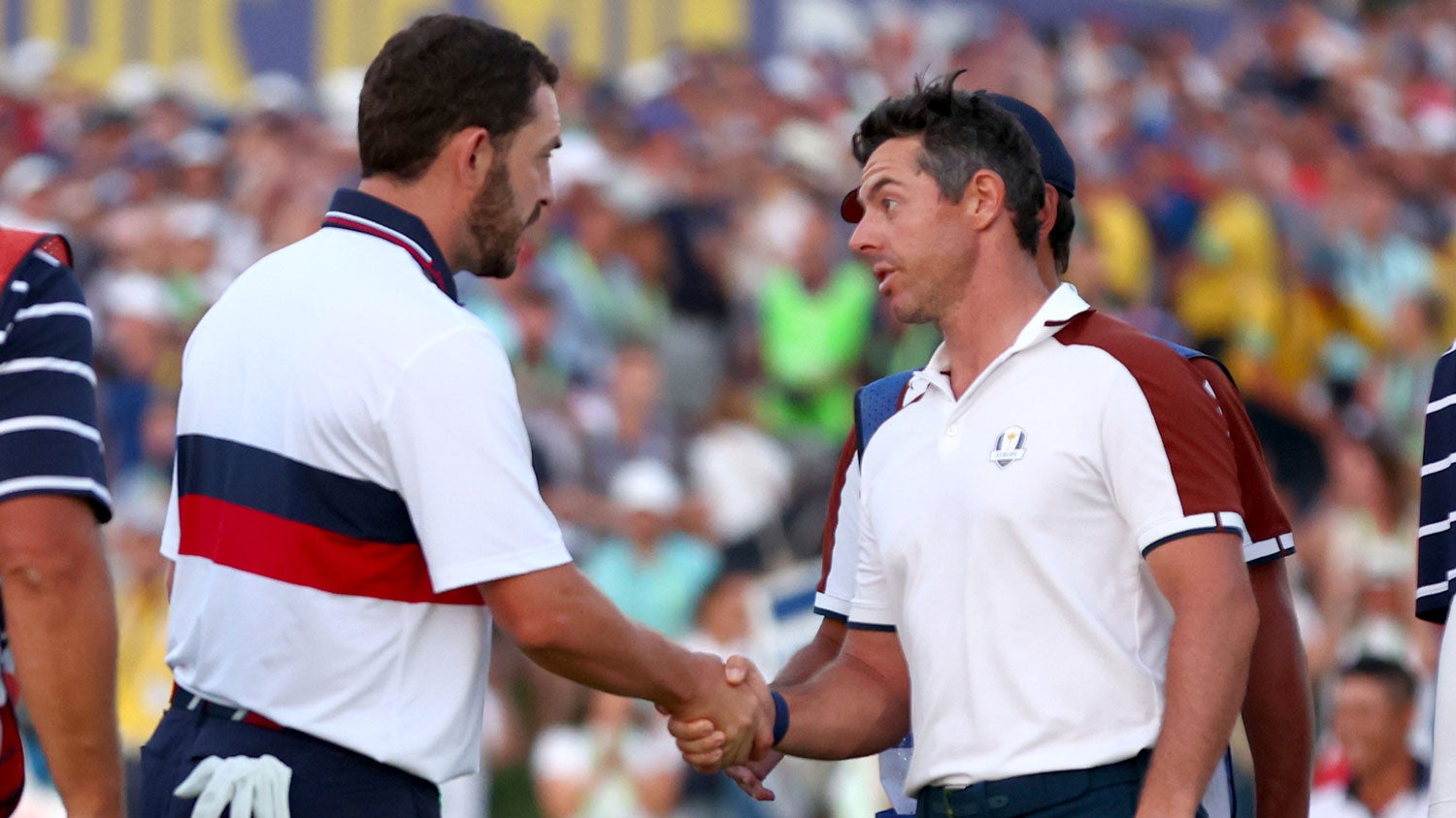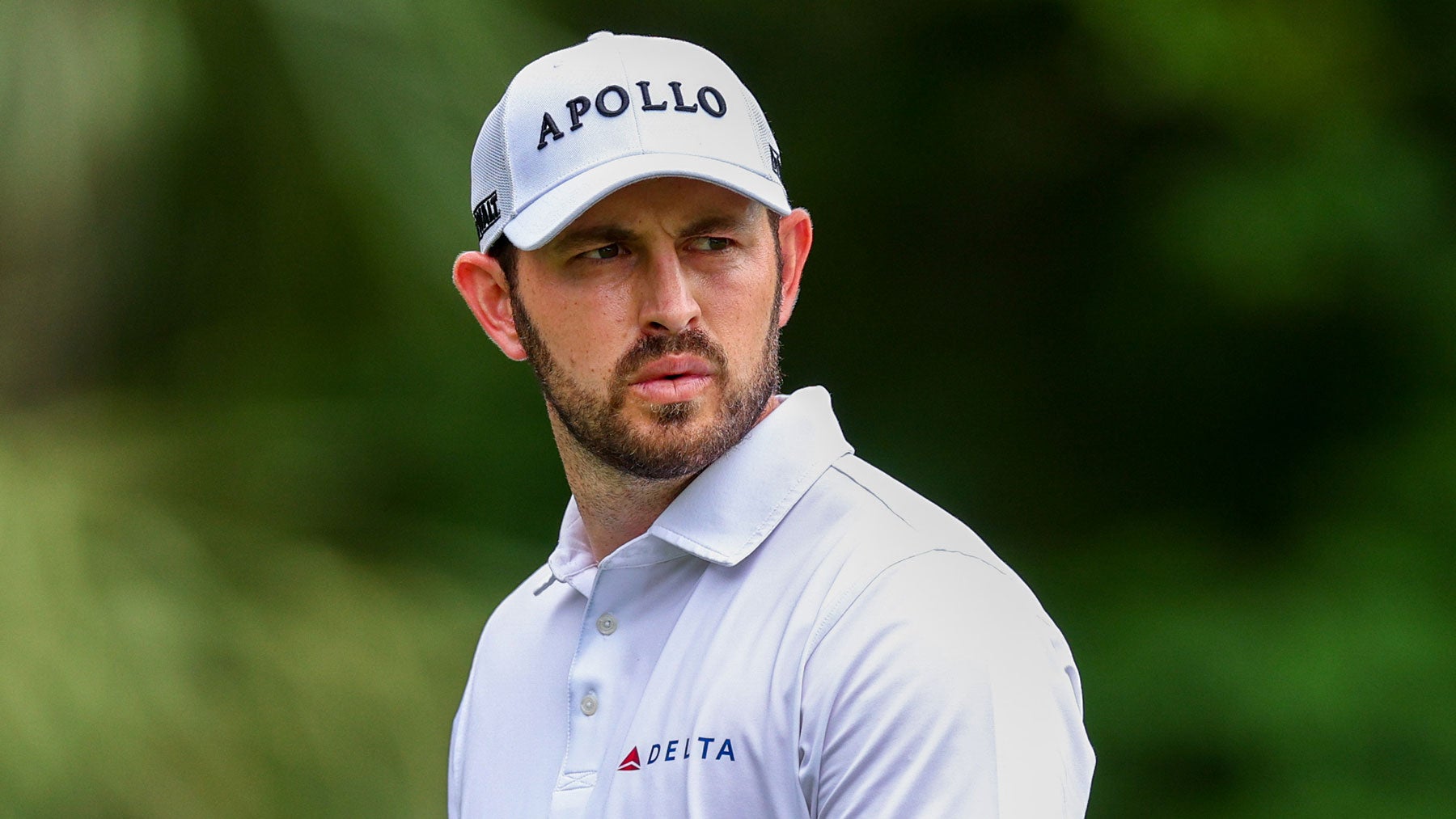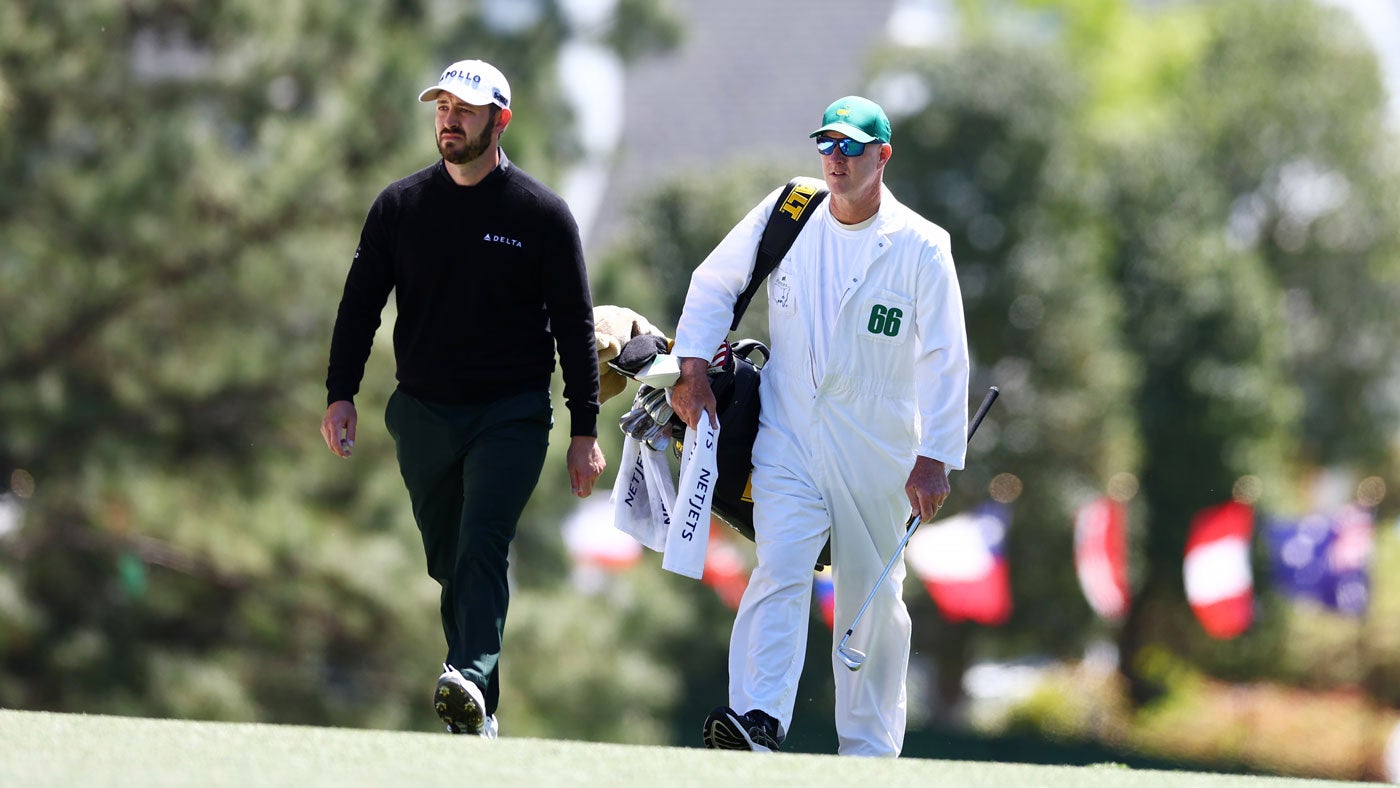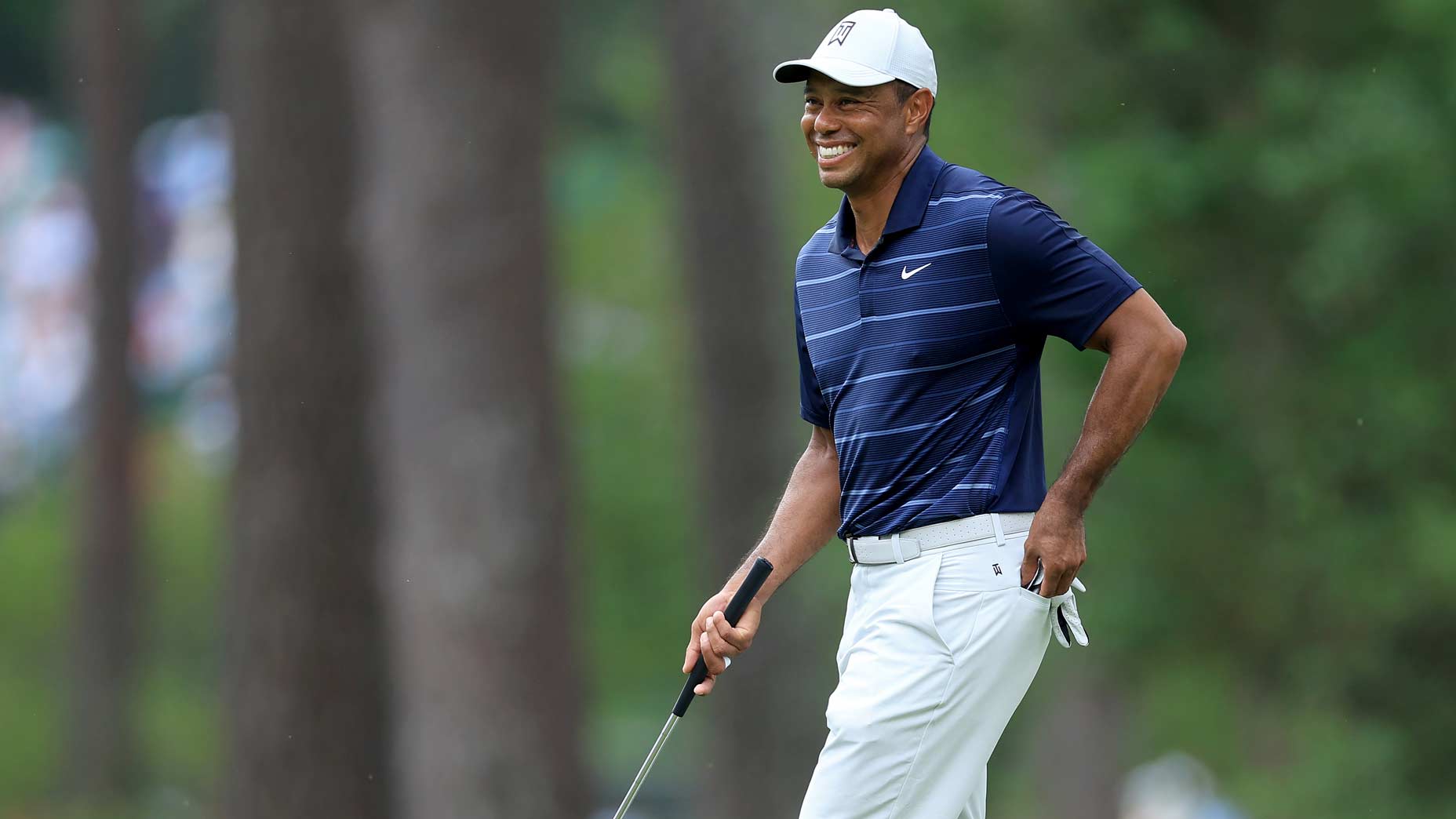The last time we saw Patrick Cantlay play, he was dispatching Justin Rose in Sunday singles at the Ryder Cup. The last time we heard Cantlay speak, he was sitting in the back row of the U.S. team’s losing press conference, talking about his hat (or lack thereof). At some point during that press conference, Cantlay offered a surprising revelation: He was, in fact, getting married the next day.
It’s safe to say that was a big week for Cantlay. It’s also safe to say this has been a big year for Cantlay. Until this season he was known to casual golf fans as a soft-spoken, mild-mannered, mysterious megatalent — someone who’d prefer his clubs do the talking for him. But that all changed in 2023. Suddenly, everyone in the golf world had an opinion on him. This was the year he became a leader on the PGA Tour. The year he contended at the Masters. The year he was accused of “seizing control” of negotiations for pro golf’s future. The year he became the center of golf’s slow-play conversation, and the center of LIV’s rumor mill, and the center of a high-profile Ryder Cup comeback (and dust-up!).
Making headlines wasn’t part of the plan. And Cantlay would probably still prefer his clubs do the talking.
But now I’m sitting with him on a sunny Southern California morning in the week after Christmas. He’s agreed to a conversation about a little bit of everything — as long as he can have breakfast while we talk. So here we are, at 8 a.m. in Long Beach, Calif., in a room at Virginia Country Club, his old stomping grounds. I order an omelet, and he summons scrambled eggs, avocado and toast, plus a side of sliced bananas and blueberries, and we get to chatting about his wildest golfing year yet.
I. YEAR IN REVIEW
How’d it go?
Cantlay did play some actual golf in 2023. Before we get to the juicy stuff we may as well start there. He played to an exceptionally high level, in fact, well enough to start and finish the year ranked inside the world’s top five. He racked up big-time finishes in the PGA Tour’s biggest events, logging top-fives at Riviera and Bay Hill and Harbour Town and the Travelers and the FedEx St. Jude Championship. He contended in the majors, too, playing in the penultimate group at the Masters and finishing T9 at the PGA Championship and T14 at the U.S. Open. It was a solid season. But he’s well aware there was something missing.
“At least a little disappointing,” Cantlay says, asked to assess his year. “Because I felt like I had multiple opportunities to win. And I didn’t win at all. And that’s always the goal.”
This is how Cantlay talks; his words trace a linear, logical path. Sometimes that makes it feel like he’s testifying on the stand. Other times it reveals his understanding of a given subject. He seems to enjoy making complex things simple, and he’s effective at it, even if his deadpan delivery sometimes lands as defiance.
“The good news is I played a lot of really good golf, and the wins are a function of putting yourself in that position,” he continues. “So I fully expect, if I put myself in that position as many times next year, I could win multiple times.”
He’s fine-tuning his approach, he says, but what he’s done is working, so if anything he’s doubling down. He’s taking the long view. He’s optimistic about 2024.
II. PAT’S PACE
Why the slow pace?
He’s talked about this part before. He knows his reputation. But does he believe what they say? Is Patrick Cantlay a slow player?
“I do think I take a very methodical approach to golf,” he says. “Well, and to life in general. But my goal out there is to be as efficient and thorough as I possibly can to shoot the lowest scores possible.”
Cantlay was in the second-to-last group on Sunday at the Masters and then in contention again at the RBC the following week. That meant golf fans got a lot of Cantlay. And some overdosed on his pre-shot routine, which involves a certain amount of shuffling over the ball.
He knows it’s not ideal. “I’m trying to find ways to be more efficient without being less thorough,” he says. Still, Cantlay would like the record to reflect that his group was never warned at the Masters or the RBC. He says he was never on the PGA Tour’s observation list, home to the slowest 10 percent of players.
I offer my theory, which is that he seems especially slow to TV viewers because of the amount of time he stands over the ball, which means the broadcast cuts to him earlier and fans are subjected to more waggling and waiting. He nods. And sighs.
“That definitely could be. I don’t watch myself on TV much, if at all. But look, I’m out there just trying to focus as much as I possibly can to execute. I mean, I only get one chance at being the best golfer I can be for a certain amount of time. Competing is maybe the most favorite thing I’ve done, no matter what I’ve been doing since I was a very little kid.
“And so when I’m out there, if I’m stoic or I take a little longer over the ball, I want people to know I’m just trying to focus as hard as I can and hit the best shot possible.”
III. PAT TO LIV?!
What’s up with the rumors?
Early in LIV’s existence, players on each side made big-time declarations. Some signed contracts with LIV. Others declared their allegiance to the PGA Tour. Cantlay? He followed his own instincts. I talked to him about the possibility of joining LIV in the fall of 2022 and then again in early 2023, and each time he said that while he didn’t anticipate joining LIV, he didn’t see the point in shutting down the idea, either. Why would it be in any player’s best interest to make a hard commitment in such an uncertain climate?
As players continued to leave for LIV and golf fans and media continued to speculate about who might make the jump next, Cantlay’s stated open-mindedness made him the subject of rumors. Whenever there was a list of players who could jump, Cantlay’s name seemed to be on it.
But here he is.
“It’s a personal calculation based on your values, your priorities, etc.,” he says now. “So I don’t think it’s a surprise that there’s a certain type of player that’s tended to go over there, on the whole. For me? I have no plans on joining LIV. I don’t plan on joining LIV. I see myself playing on the PGA Tour.”
Cantlay does acknowledge his team has had discussions with LIV in the past, including at least one in 2023. But the proof, he says, is in the pudding.
“I declined offers,” he says. “Pre and post joining the board. And the most recent offer I got, I declined in the same meeting that my management team brought it to me.”
IV. POLITICIAN PAT
Is Cantlay “in control”?
In just a few months, Cantlay was the subject of a pair of explosive — and conflicting — rumors. The first, that he was defecting to LIV, seemed inherently incompatible with the second, that he was chief architect of a PGA Tour coup d’etat. And yet, in early December, a report from Sports Illustrated carried a shocking headline: “Patrick Cantlay is in Control.”
In control of what? Let’s back up.
2023 marked Cantlay’s first year as a member of the Tour’s policy board. That’s always been an important position, but never more than it is right now, with the future of the Tour hanging in the balance.
Given travel, sponsor and practice schedules, it’s always been interesting to see which players are willing to join the board. I point that out to Cantlay. For a guy as focused as he is on eliminating inefficiencies to help maximize his golf game, joining seemed like a serious time suck and a fairly thankless task. Why do it?
“I care a lot about the PGA Tour. I grew up wanting to play on the PGA Tour and win tournaments on the PGA Tour, and I’ve been fortunate enough to have done that,” he says. “So when I joined the board, I viewed that as a responsibility. It was important for me to take that very seriously and I have taken that very seriously.”
He hammers these points home in the minutes that follow. No, he didn’t know the scope of what he was signing up for — how could he have? But he takes his responsibility incredibly seriously. He sees it as his duty to represent every player. And he emphasizes cohesion among the player directors.
“And I think it’s important to take it seriously,” he adds. “My goal, being on the PGA Tour Policy Board, is to represent all the members, both current and future, to the best of my ability. And so that’s what I’ve been trying to do. That’s what all the player directors have been trying to do. And we’ve been working really closely together over the last many months as a unit to make the best collective decisions that represent the interests of all the members.”
Cantlay had initially joined for one year, but in November the player directors unanimously voted to reappoint Cantlay for an additional three-year term that will run through the 2026 season. He takes pride in that vote of confidence from his peers.
“Like I said, I care a lot about the PGA Tour and I’m invested, not financially but personally invested, in this role.”
The SI report accused Cantlay of fighting for the PGA Tour’s upper crust; he denies that characterization, insisting again that his job is to represent every member.
“With a membership as wide-ranging as the PGA Tour it’s to be expected that there are different perspectives,” he says. “Right now we’re fortunate to have a nice mix of player directors that represent different factions of the Tour. And that’s why it’s been so important for us to work so closely together and have those conversations so we can come to the best decision for all members, collectively, both current and future.”
As for that particularly juicy bit — the idea that he’s seized control? That he had become “arguably the most powerful person on the PGA Tour, including the commissioner”? What does Cantlay make of that?
He pauses.
“I just don’t think you can trust everything you read on the internet,” he says, simply. But then he offers a more specific rebuttal.
“I think if you just look at the facts that are out there, it would be impossible for any one player to take control,” he said. “I mean, it would be impossible for all the players together to take control; we only have half the seats on the board, and any major vote around any of the things we’ve been talking about requires a two-thirds majority. And also, considering that the Tour has hired [the titan investment bank] Allen and Co., and given the Tour has been driving discussions since even before the framework agreement was announced, I mean, given that set of facts it’s just impossible for that to be the case.”
I’m curious whether he sees June 6 — the day the framework agreement with the PIF was signed — as a good or bad day for the PGA Tour. That’s a question, he says, that can only be accurately answered in the future. Does he know how this will end? No. Does he know when it will end? Nope. Does he have an outcome he’s rooting for? “The best possible outcome for the PGA Tour,” he says. Sigh.
Back to the reports, then. A Golfweek report as far back as June alleged Cantlay was rallying players against the PIF deal. Is he opposed to the Saudis’ involvement?
“If the best option for the Tour is with PIF, then I’m all for that,” he says. “The guiding light for the player directors and the whole board is to do what’s best for the PGA Tour.”
There’s not much more he can say about the negotiations; they’re ongoing, so that makes sense. But I’m curious for whatever details he’s willing to offer. How many meetings are there? How long do they take? There are a lot of meetings, he says. Some are brief. But the official board meetings?
“Those can take almost the whole day.”
What are his peers like in the room? Collaborative, he says. Impressive. How about Tiger Woods, who joined in August? Here he offers a little more.
“Tiger’s fantastic,” he says. “Tiger is a natural leader among us. All us players owe Tiger a lot not just for growing the sport but now for being willing to invest lots of time back into the Tour to help make it as good as it can be. I think it’s a real testament to him that he could have the career that he’s had and still be willing to spend time trying to better the PGA Tour. We’re better off for having him involved in more ways than one.”
V. PAT’S PEERS
Who has come to his defense?
A funny thing has happened with Cantlay the past few months: Fellow pros have spoken out specifically in his defense.
In the wake of the Golfweek article charging Cantlay with staging an “artless coup,” Adam Scott took to Instagram to state his objection, accompanied by the caption, “Serious times require serious perspective.”
“Putting aside personal barbs and fluffy adjectives would be helpful, dealing with facts presented with integrity far superior,” Scott wrote. “Talk of a Cantlay coup d’etat – really? Perhaps some proof rather than faceless speculation?”
It was a notable statement. PGA Tour players don’t often speak out about anything, let alone fellow players. It grew more notable when the post was shared by high-profile players like Rickie Fowler, Justin Thomas, Max Homa and Will Zalatoris.
The latest round of Cantlay critiques drew further defense from his peers. Jordan Spieth spoke to the Associated Press to refute the claim that Cantlay had seized control. Here’s how that read:
Spieth said Cantlay might be an easy target because of his personality.
“But he’s very smart and he’s very measured in everything he says,” Spieth said. “He doesn’t waste words, and a lot of times that comes across as demanding.
“In no way, shape or form does he control anything. He wants objectivity when it seems that isn’t the case. He, like the rest of us, are all in agreement. We may disagree on how, when and why. But our collective duties are to represent the players — deal, no deal, multiple partners.”
Justin Thomas added his thoughts on the matter at the PNC Championship. Here’s how that sounded:
“I have so much respect for those guys on the board and the amount of time and effort that they have put in, and the families for being good with it.
“It’s been frustrating on my end as a player to have someone on the board, and have the things that Patrick Cantlay has had said about them. I understand Patrick is who he is, but he’s beyond busted his ass to get the Tour in the best place possible, and with the rest of the guys on the PGA Tour board to make things the best possible place for us players going forward. And I know all of them have done that.”
Even Jon Rahm shouted out Cantlay en route to joining LIV. From his Fox News interview:
“I certainly hope they all accomplish what they set out to accomplish when the top players got together during this movement, in this changing environment we’ve had in golf. My message to them is that I hope we can accomplish what the goal is and what the goal will be.
“I’m very thankful for the work that many of them have done. Obviously highlighted by, the names that come to mind are Patrick Cantlay, Rory [McIlroy] and Tiger Woods. They’ve spent a lot of time in meetings and phone calls learning about what the future of the game might look like. I want to say thank you and I truly hope they result is what they want.”
I ask Cantlay how it feels to have such high-profile support. He demurs.
“I think all the members want what’s best for the PGA Tour membership. I think the player directors have been working extremely hard to get the best outcome for the collective membership. And so I think guys might be recognizing that the player directors are working as hard as they can to ultimately improve the situation for the collective members.”
VI. PAT AND THE HAT
What happened at the Ryder Cup?
Cantlay has already finished his eggs and his avocado and most of his toast, too, which has me realizing our time is suddenly shorter than I’d hoped. After all, our entire interview could have focused on the events of Ryder Cup Saturday. About “HatGate.” About his alleged silent protest and demands for money. About reports of a divided U.S. team room. About a wild afternoon match that got about as close to a bench-clearing brawl as any golf tournament you’ll see.
If you’ll recall, that Ryder Cup Saturday began with the U.S. team in a big hole after failing to win any of the first eight matches. The morning didn’t start much better; Team Europe had taken two of the first three matches, and before long Cantlay and his partner Xander Schauffele were in the only match still on the course.
But the fans flocking to see Cantlay and Schauffele were coming armed with new information: A Sky Sports report alleging a “fractured” U.S. team room — with Cantlay to blame.
“Understand from several sources that the US team room is fractured, a split led predominantly by Patrick Cantlay,” reporter Jamie Weir wrote in a tweet. “Cantlay believes players should be paid to participate in the Ryder Cup, and is demonstrating his frustration at not being paid by refusing to wear a team cap.”
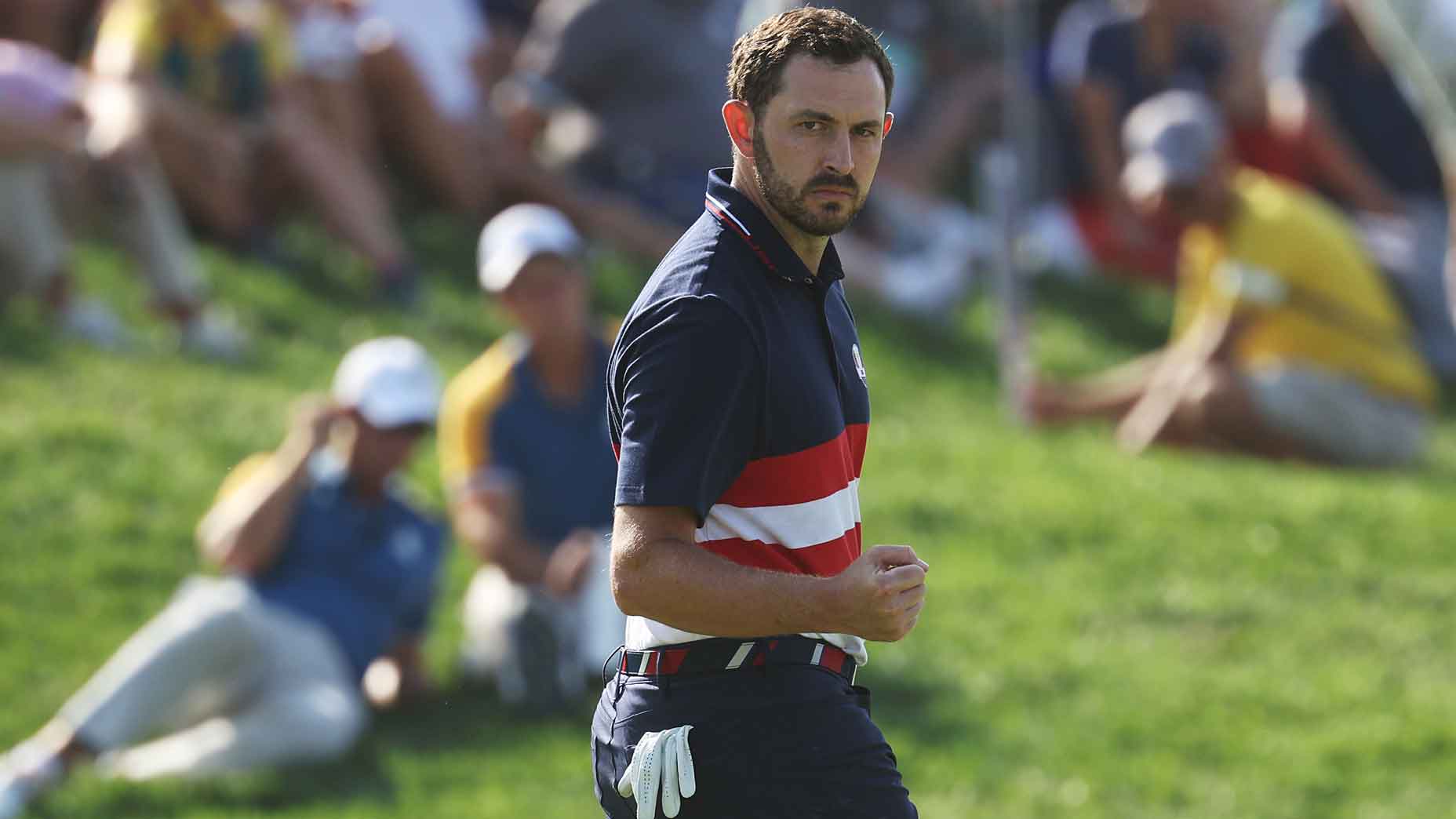
Several allegations followed, including the idea that Cantlay and Schauffele were in a separate section of the locker room. It painted a picture of a team in disarray and, given the scoreboard, the European fans eagerly bought in. What followed was a particularly memorable day in Ryder Cup history.
Where to begin?
“I love those events,” Cantlay says, wanting to make this part clear. “I love representing the other guys and the captains that are on the team. They’re some of my favorite weeks and some of my favorite memories in golf and I care a ton about the Ryder Cup and a ton about trying to win the Ryder Cup for the United States. And when I’m over there the only thing I’m trying to do is work with the guys, have fun and bring the cup home.”
But he’s dismayed that the report made it past that weekend.
“There was zero divide,” he says. “I think if you asked all the assistant captains, the captain, the players, they would tell you it’s one of the closest locker rooms they’ve been a part of.”
There’s more, of course. He dismisses the idea that the decision to bar Netflix cameras from the U.S. team room came from him, a sticking point in the run-up to the event.
“We all came to a unanimous decision that it would probably be best for the locker room to stay a sanctuary for the players during a high-stress environment like the Ryder Cup,” he says.
As for the issue of players getting paid?
“The money issue was not talked about, at all, leading up to the Ryder Cup or during the week of the Ryder Cup,” he says.
Okay, so why didn’t he wear a hat during Ryder Cup week?
He shakes his head.
“It’s so funny, like, Whistling Straits Ryder Cup I was ‘no-hat Pat,’” he says, referencing the 2021 event in Wisconsin where Cantlay stayed mostly hatless in a U.S. victory. “And we go to Europe and they’ve figured out a way to turn it against me. That is quintessential Ryder Cup. Look, I didn’t wear a hat because the hat didn’t fit exactly as I would have liked. I’m very particular about pretty much anything I put on. And I just didn’t feel comfortable wearing it; I felt more comfortable without it. There is just nothing more behind it than I just felt more comfortable not wearing one.”
Another version of the story had Cantlay telling a PGA of America official and NBC Sports broadcaster Steve Sands before the start of a practice round that he wouldn’t wear a hat unless he was getting paid to do so. The comment might have been flippant, but it seemed to support some parts of the report. But it’s worth noting that Cantlay didn’t wear a hat at various team competitions dating all the way back to the 2011 Walker Cup and many of his matches at UCLA. He denies vehemently that the hat had anything to do with a protest.
“I’ll say one thing. If I was to make a protest, everyone would know what I’m protesting, why I’m protesting and how I’m protesting,” Cantlay says, grinning. “I would never, never do a silent protest.”
Back to that Saturday, then. There wasn’t much time between the end of Cantlay and Schauffele’s morning match and his afternoon tee time; pairings were announced as they played the 16th hole. After they lost on the 17th green, Cantlay rode back to the clubhouse, scarfed down a quick lunch and went to warm up alongside afternoon partner Wyndham Clark. At that point he insists he still knew nothing of the report.
“I had no idea of any of it,” he says. “Wyndham was on the range. We hit balls next to each other, and Wyndham and I hadn’t played a match together before. He turned to me and said, ‘Hey, I’ll go first on every tee. Is that fine?’ And I said ‘Yeah, of course that’s fine, go first.’ And then he said, ‘I hear you love playing birdie games. So why don’t you and I have a birdie game?’ And I said ‘Okay, yeah, let’s have a birdie game.’ And then we went to the first tee together and I told him, ‘Listen, it’s Saturday at the Ryder Cup’ and just reinforced, like, ‘It’s going to be intense. But I’ve got you. We’re on the same team. And we’re gonna get this done.’”
From outside the ropes, the scene was surreal. I recall to Cantlay trying to estimate the number of spectators on the drivable par-4 16th — 10,000? 15,000? More?! — and how remarkable it was to watch them waving their hats in his direction, singing, among other renditions, “Hats off for your bank account.” Cantlay wasn’t oblivious to their yelling or waving. But he didn’t really have the full picture.
“Even during the match I couldn’t understand what they were chanting,” he says. “I knew they were chanting at me and making fun of me for not having a hat on, which I thought, fair play, whatever you guys want to do to try and help your home team win, that’s part of the Ryder Cup. That’s what makes it so great. But I didn’t realize the genesis of it until after I completed the afternoon match.”
It was impossible to block out, but Cantlay seemed to embrace the hostility. He says he drew on a lesson he learned from a certain high-profile U.S. Presidents Cup captain.
“You know, the first team event I played was Royal Melbourne and Tiger was the captain,” Cantlay says. Woods took that Saturday off from playing, but he joined Cantlay for a crucial moment in the match on the par-5 15th.
“I was even or 1 up and it’s an easy par-5. I knew I needed to make a birdie to keep the foot on the gas, to keep the momentum rolling. And so, it being my first team match, I was more nervous than I would usually be,” he remembers. “So I was chatting with Tiger and picking his brain and I was basically like, ‘How did you get through all those high-pressure moments?’
“And he said, ‘I just would tell myself, “Go to work.”’ And then he just looked at me and he was like, ‘Go to work.’ And then he was just gone, off to some other hole. And so that’s the mindset I was in. I was just going to work. I just wanted to get the job done. I wanted to get the point.”
Cantlay went to work on the 16th green, where he poured in a crucial 10-footer for birdie. He seemed plenty focused on the 17th tee, where he flagged an iron shot inside 10 feet and made that, too. And he seemed plenty focused on the 18th green, where every golfer and every fan on property encircled the final green in the day’s fading light and watched as Cantlay poured in a 43-footer for birdie that set the scene ablaze.
How does he make sense of it, looking back at that afternoon?
“I just think that the Ryder Cup brings out the most emotion in golf,” he says. “You can see it in me; it’s the most animated I ever get, and that just feels natural. I’m not acting, it just comes out because of the tension that’s created in that event. I think that’s why fans love it. It’s just high-pressure, high-tension.”
How incredible was that moment on 18?
“I think I said it in my interview right after but we just needed some type of momentum change to have any chance. So it was nice to have one positive moment for the team in a week that had many not-so-positive moments. And so knowing that Wyndham and I were the anchor match, I knew it was very important for us to get a full point given the overall score. Everyone knew we still had a ton of work to do Sunday. But it did give us maybe a glimmer of hope to do something like what [Team Europe] did at Medinah.”
But what made the putt on 18 so memorable were the moments that followed. Caddie Joe LaCava stood at the center of the scene, slowly turning in a circle as he waved his hat to the crowd, returning the gesture they’d given his man all afternoon. It was an uncharacteristic moment for LaCava, who has always tried to avoid the spotlight. But he’s fiercely loyal to his guy.
I’m curious if Cantlay — hardly an attention-seeker himself — was upset with his caddie for finding himself at the center of the conflagration. He pauses before answering.
“Like I said, I think it’s just high pressure, high tension,” he says. “You’d have to ask him. I think when you’re in the moment your brain interprets it one way and then when you have some time to reflect, you might have done it a different way. But Joe LaCava is the best. He’s the best ever.”
And then there’s the matter of Rory McIlroy. McIlroy popped off at LaCava on the green. He popped off at Bones Mackay an hour later as he tried to storm the U.S. team room. He remembered the scene some weeks later to Paul Kimmage, where he described his relationship with Cantlay as “average at best,” and, remembering the moment, said he was screaming about LaCava as “caddying for that d—.”
From the outside there seemed to be something more to it than just one Ryder Cup duo beating another. McIlroy seemed to allude to that. “We don’t have a ton in common and see the world quite differently,” he said in the same interview. The two had spent countless hours together on the Policy Board. They’d spent time together in tournament play, too, including a month earlier on Sunday of the FedEx St. Jude Championship, where Cantlay bettered McIlroy’s 65 with a 64 to get into a playoff. It’s easy to contrast their personalities; McIlroy wears his heart on his sleeve while Cantlay is generally inscrutable. You’d understand why they might want to beat each other a little extra.
But it’s clear Cantlay isn’t interested in escalating any war of words. He’s measured in his assessment of the moment — and of their relationship.
“I think we’re both highly competitive and we’re both trying to be the absolute best,” he says. “I think we both admire that part of each other. As far as the Policy Board goes, we’ve worked really closely together and had a really good working relationship over my year on the board.
“Look, I talked to him post-Ryder Cup and, y’know, everything was cordial and all good.”
As for the “d—” comment?
“Yeah, I saw that. I think it was taken out of context. And that’s kind of the world we live in, where the headline drives the story,” he says.
VII. POST-CUP PAT
What happened after?
I’m curious if Cantlay was tempted to correct the record. In the immediate aftermath of the Ryder Cup, did he think about putting out some sort of clarifying statement? That there was no rift? No protest?
It turns out Cantlay felt like the U.S. team had done that.
“I thought that I was and the other players were pretty definitive about that,” he says, referring to the unified front they presented at their post-Cup press conference.
For Cantlay, though, the week was only getting more remarkable. After Ryder Cup Sunday came Monday — and on that Monday Cantlay had plans: his wedding in Rome to his now-wife, Nikki. I’m admittedly reluctant to ask how being at the center of a controversial Ryder Cup loss affected his wedding day, but I do anyway. Some of his teammates were at the wedding, after all.
“Everyone wants to make more of the golf part of my life because that’s the public part of my life. And I understand why that is,” Cantlay says. “But look, there’s bigger stuff.”
The look in his eye changes here. The tenor of the conversation does, too. Cantlay recalls his longtime friend and caddie Chris Roth, who died in a hit-and-run car accident just a few feet from him when the two were out together in Newport Beach in 2016. If some of the drama of the last 12 months seems trivial, well, there’s a reason for that.
“When my buddy Chris died, it was immediately the most important thing in my life,” he remembers. “A million times more important than anything else. An order of magnitude greater than anything else that had happened in my life. And I felt that. It was something golf could never compare to.
“And look, this is something completely on the other side of the spectrum. All the way across. The best. But getting married to Nikki is going to impact my life in such a significant way, such a more substantial way than golf could. It was maybe the single most important day of my life, so important that the days surrounding it really meant nothing.”
We continue chatting for a final few minutes, but that effectively marks the end of the conversation. It’s not that the Ryder Cup is insignificant, nor the PGA Tour and the PIF and Cantlay’s role in determining their potential future. It’s just that there after a year filled with rumors and reports about slow play and hats, his focus remains on the things he can control.
I tell him to pass along an apology to his physio, who’s already waiting by the range. His coach, Jamie Mulligan, is there too. There’s work to do. Cantlay’s playing the long game.
After all, his next year will be busy, too. And next year is just a week away.
Dylan (cautiously) welcomes your comments at dylan_dethier@golf.com.




